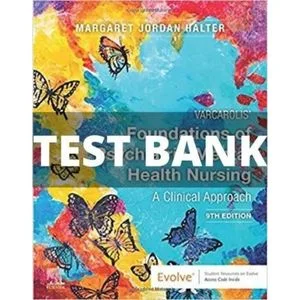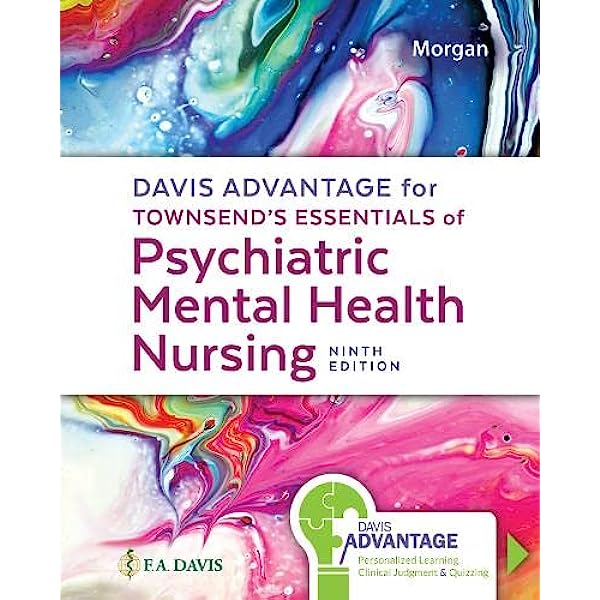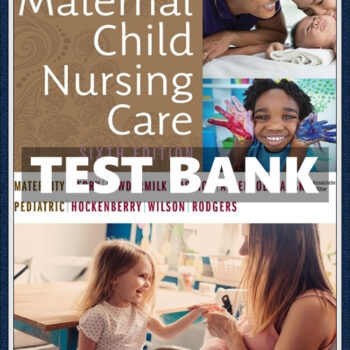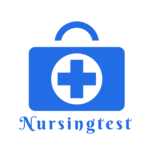
Test Bank For Nursing Leadership and Management Canadian 1st Edition by Alice Gaudine
Original price was: $55.00.$28.00Current price is: $28.00.
Digital item No Waiting Time Instant DownloadISBN-10 : 0132735970ISBN-13 : 978-0132735971
As a student or a professional in the nursing field, the right resources can make all the difference in your education or practice. The Test Bank for Nursing Leadership and Management Canadian 1st Edition by author Alice Gaudine is a must-useable resource that can improve good academic performance. This test bank is intended to serve as a useful addition to your textbook, and it includes many questions and answers on the core topics and skills being studied.
What Are the Advantages of This Test Bank?
The strife that nursing students undergo in nursing school is understandable. This is why this test bank is designed to be student-friendly and assist you in your learning efforts. A wide variety of questions that resemble potential test questions are included in this question bank. As you practice these questions, you increase your confidence and sharpen your ability to take exams.
Picture this, walking to the exam room, with peace of mind that you are fully prepared for the task. You can easily get there with the help of this test bank as you are now used to practicing questions that you will see on the day of the exam. Rather than pump information into your brain on rote memory, you will learn how to utilize ideas in practice.
Main Ideas Discussed
The test bank includes the resources of many essentials such as:
- Leadership Styles: Cover some nursing leadership styles and their application in practice. Learning these styles will assist you as a nurse leader in any healthcare facility.
- Management Skills: Identify and describe basic skills necessary for team and patient management. Such skills are essential for the optimal functioning of healthcare teams.
- Communication: Indicate effective communication skills vital for patients, families, and healthcare teams. Effective communication is central to patient outcomes and the achievement of nursing leadership roles.
- Decision Making: Therefore, all nurses must be able to develop the skills necessary for making decisions in challenging situations. This is critical in ensuring optimal patient care and appropriate leadership of healthcare teams.
How This Test Bank Helps You
With the use of this test bank, you can:
- Improve Knowledge Acquisition: Practice class concepts through appropriate questions. These questions provide a practical sense to the student and make their studies worthwhile.
- Take Tests: Practice and sit for examinations using questions that depict genuine testing situations. You will be in a simulated environment that feels like an examination which may prevent anxiety and enhance performance.
- Enhance Your Self-Esteem: Get the self-esteem required to make it big in your nursing career. Confidence comes from knowing you are prepared, and this test bank makes sure that you are well-prepared for anything that life throws at you.
What we have to offer
We aim to assist students with quality educational resources that are in line with the newly endorsed educational policies. This test bank is periodically changed so that it is always up to date with the modified procedures and guidelines of nursing. You can be confident that the content is correct and applicable to the conditions of current health services.
Start With Us
You are not just choosing the test bank, but a community of students and professionals striving for excellence in nursing. We help all learners in reaching their goals effortlessly. Interact with learners on the same path, share your stories, and learn from their experiences. It’s possible to do much when people work together.
Summary
The Test Bank for Nursing Leadership and Management Canadian 1st Edition desk is not just a resource for your classroom revision it is also an instrument for nursing success in your career. This resource if used effectively as part of your study habits, will certainly improve your comprehension, increase your competencies, and help you meet your academic and professional objectives.
Imagine how pleasing it will be to pass your exams and progress in your future profession. This test bank is with you in achieving that success. With perseverance and great resources, there aren’t any boundaries to what one can accomplish in nursing.
Test Bank For Nursing Leadership and Management Canadian 1st Edition by Alice Gaudine
Multiple Choice Questions
1) Fayol’s principles of management that continue today include __________.
a. division of work, authority, hierarchy, and democracy
b. unity of command, scalar chain, centralization, and discipline
c. division of work, scalar chain, hierarchy, and disciplined. unity of command, scalar chain, centralization, and democracy
Answer: b
Rationale for Correct Answer:
- Incorrect: Hierarchy and democracy are not included in Fayol’s principles of management.
- Correct: These principles, along with the division of work, authority, and subordination of interest, are all included in Fayol’s principles of management.
- Incorrect: Hierarchy is not included in Fayol’s principles of management.
- Incorrect: Democracy is not included in Fayol’s principles of management.
Client need per NCLEX: safe and effective care environment
Integrated Nursing Process: Assessment, Planning, Implementation
Objective: 1—Discuss the evolution of theories of management and how they are reflected in current healthcare organizations
2) Fayol’s categories of management functions include __________.
a. controlling, leading, staffing, organizing, and planning
b. controlling, leading, staffing, organizing, and productivity
c. controlling, leading, staffing, organizing, and promotion
d. controlling, leading, staffing, organizing, and priority
Answer: a
Rationale for Correct Answer:
- Correct: These are all included in Fayol’s categories of management functions.
- Incorrect: Productivity, promotion, and priority are not included in Fayol’s categories of management.
- Incorrect: Productivity, promotion, and priority are not included in Fayol’s categories of management.
- Incorrect: Productivity, promotion, and priority are not included in Fayol’s categories of management.
Client need per NCLEX: safe and effective care environment
Integrated Nursing Process: Assessment, Planning, Implementation
Objective: 1—Discuss the evolution of theories of management and how they are reflected in current healthcare organizations
3) Concerns of __________ include dealing with complexity and producing results, quality, and planning, and setting targets and goals while dealing with budgeting and allocating resources.
a. management
b. administration
c. leadership
d. frontline staff
Answer: a
Rationale for Correct Answer:
- Correct: See Table 2.1 (p. 37) in your textbook for a list of management functions.
- Incorrect: See Table 2.1 (p. 37) in your textbook for a list of management functions.
- Incorrect: See Table 2.1 (p. 37) in your textbook for a list of management functions.
- Incorrect: See Table 2.1 (p. 37) in your textbook for a list of management functions.
Client need pneedsCLEX: safe and effective care environmentIntegrated Nursing Process: Assessment, Planning, ImplementationObjective: 2—Compare the focus and activities of leaders and managers.
4) _________ includes motivating, inspiring, and empowering people to pursue change and overcome barriers by coaching and role modeling.
a. Management
b. Administration
c. Leadership
d. frontline staff
Answer: c
Rationale for Correct Answer:
- Incorrect: See Table 2.1 (p. 37) in your textbook for a list of leadership functions.
- Incorrect: See Table 2.1 (p. 37) in your textbook for a list of leadership functions.
- Correct: See Table 2.1 (p. 37) in your textbook for a list of leadership functions.
- Incorrect: See Table 2.1 (p. 37) in your textbook for a list of leadership functions.
Client needs per NCLEX: Safe and effective care environmentIntegrated Nursing Process: Assessment, Diagnosis, Planning, Implementation, EvaluationObjective: 2—Compare the focus and activities of leaders and managers.
5) A(n) __________ health care delivery system that has an evident private market and provides public funding for the poor and/or elderly is:
a. universal and comprehensive
b. entrepreneurial and permissive
c. socialist and centrally planned
d. welfare-oriented
Answer: b
Rationale for Correct Answer:
- Incorrect: Universal and comprehensive services are publicly funded and provide a full range of services for all citizens.
- Correct: In entrepreneurial systems, individuals purchase health insurance or work for employers that purchase such insurance for employees under private insurance schemes, and most health care is paid for in this way. Such systems often feature a mix of publicly funded services for the poor and/or elderly, with most services being provided and paid for privately.
- Incorrect: Socialistic and centrally planned services are available to all citizens and are designed and delivered by government-funded organizations.
- Incorrect: In welfare-oriented health systems (such as Canada’s), governments take on the role of funding only a portion of services, such as hospitals and physicians, but not a full range of health care services.
Client need per NCLEX: safe and effective care environment, health promotion and maintenance integrated Nursing Process: Assessment, Diagnosis, Planning, Implementation, EvaluationObjective: 3—Identify the components of health systems and the factors influencing the organization of health systems
6) Canada’s health care system is classified as __________.
a. universal and comprehensive
b. entrepreneurial and permissive
c. socialist and centrally planned
d. welfare-oriented
Answer: d
Rationale for Correct Answer:
- Incorrect: Sweden and the United Kingdom are examples of universal and comprehensive health systems.
- Incorrect: The United States is an example of an entrepreneurial and permissive health system.
- Incorrect: China and Cuba are examples of socialist and centrally-planned health systems.
- Correct: Canada and Japan are examples of welfare-oriented health systems.
Client needs per NCLEX: safe and effective care environment, health promotion and maintenanceIntegrated Nursing Process: PlanningObjective: 3—Identify the components of health systems and the factors influencing the organization of health services.






